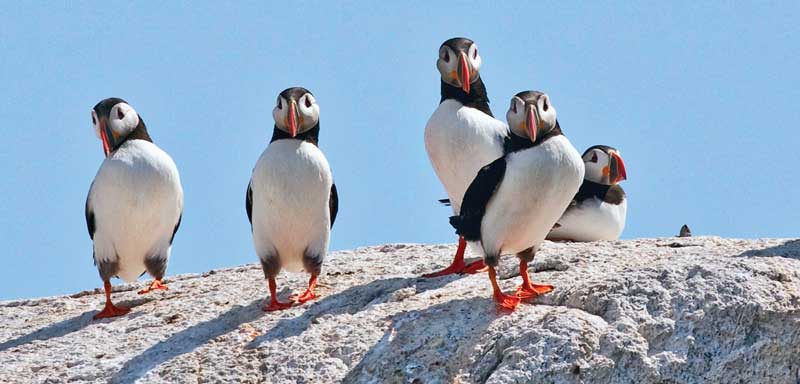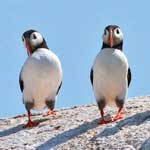
A small downy gray chick waits patiently on an exposed rocky ledge on Mantinicus Rock. The huddled chick is a common murre and its presence there is something of a miracle. It has been almost 150 years since common murres bred and nested on this windswept granite island. Mantinicus Rock is part of the Maine Coastal Islands National Wildlife Refuge and it is through the efforts and dedication of refuge staff and supporters that the murres have returned.
Seabird colony management and restoration is the focus of much of the work on the Refuge’s 72 islands and four mainland sites. Refuge biologists, graduate students and interns work to manage and create nesting habitat, control predators and conduct vital research. Their work is absolutely crucial to the survival of many of the coast’s most endangered and threatened seabirds. Currently, significant percentages of the entire breeding populations of Atlantic seabirds reproduce within the refuge’s 8,238 acres of preserved habitat. In addition to the common murres, 85 percent of Atlantic puffins and 95 percent of Arctic terns remaining in the lower 48 states nest on islands within the refuge. It is no exaggeration to say that without these islands and the work of the dedicated refuge staff, many of these nesting colonies would cease to exist.
The Friends of the Maine Coastal Islands National Wildlife Refuge was founded to support the Refuge in its efforts to conserve, preserve and enhance the rich diversity of coastal habitats, seabirds and other wildlife. With a focus on advocacy, public outreach and fundraising for crucial refuge work, the friends group supplements the efforts of refuge staff and helps maintain a stable funding base. Most of the refuge consists of off-shore islands, which are inaccessible or closed to the public for a portion of the year. This makes it difficult for the public to understand the value of the refuge and the work that goes on there. The friends group plays a critical role in raising public awareness of endangered and threatened seabirds and what the refuge is doing to preserve them.
 The public face of the refuge is a visitor’s center located at 9 Water Street in Rockland, Maine. There, trained docents lead visitors through interactive exhibits, conduct children’s educational programs and run a gift store that raises funds to supplement and support the work of refuge staff. Every year the friends group funds salaries for eight interns who spend the summer living on remote refuge islands where they assist in vital research and protect the seabird nesting colonies from animal predators and human interference. It’s a life changing experience for the interns and their presence is a critical factor in survival of the nesting colonies.
The public face of the refuge is a visitor’s center located at 9 Water Street in Rockland, Maine. There, trained docents lead visitors through interactive exhibits, conduct children’s educational programs and run a gift store that raises funds to supplement and support the work of refuge staff. Every year the friends group funds salaries for eight interns who spend the summer living on remote refuge islands where they assist in vital research and protect the seabird nesting colonies from animal predators and human interference. It’s a life changing experience for the interns and their presence is a critical factor in survival of the nesting colonies.
What would kayaking or sailing in Maine waters be like without the sight and sound of a laughing gull, a common tern or any one of the many seabirds that grace our waters and our skies? The Maine Coastal Islands National Wildlife Refuge will continue to provide places of shelter and protection for these birds and other coastal wildlife and the friends of the refuge will be there to assist in these efforts.

This page is sponsored by the Ocean Ledges Fund of the Maine Community Foundation with the goal of supporting education and conservation
For more information about the Maine Coastal Islands National Wildlife Refuge, click HERE
For information about the friends, click HERE ■







